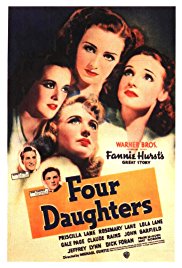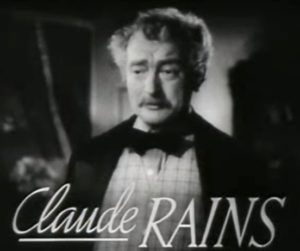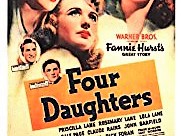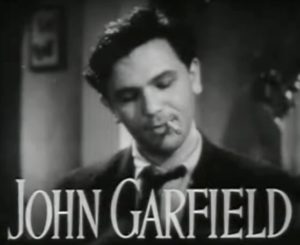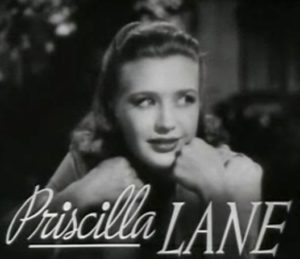Four Daughters **** (1938, Claude Rains, John Garfield, Jeffrey Lynn, Priscilla Lane, Rosemary Lane, Lola Lane, Gale Page, May Robson) – Classic Movie Review 6084
Director Michael Curtiz’s 1938 movie tells the sentimental but highly appealing soap-opera story of romance for four early adult sisters in a small American town. It was nominated for five Oscars, including Best Picture, Best Screenplay, Best Actor in a Supporting Role (John Garfield), Best Director (Curtiz) and Best Sound, Recording (Nathan Levinson).
The sisters – Ann, Kay, Thea, Emma, and – are played by the three real-life actress Lane sisters, Priscilla, Rosemary and Lola, and Gale Page. Tremendous though the performances of the girls are, it is John Garfield (in his film début) who gives the most stupendous turn that shoots him to stardom as Mickey Borden, a sharp but shabby and self-pitying drifter who wreaks emotional havoc among the family as Ann (Priscilla Lane)’s lover.
Claude Rains as the music professor patriarch, Adam Lemp, the dean of the Briarwood Music Foundation, May Robson as the girls’ aunt Etta and Jeffrey Lynn as their new young boarder Felix Deitz also score hit acting turns.
There is a spruce and tidy script by Julius J Epstein and Lenore J Coffee from Fannie Hurst’s short story Sister Act, as well as sharply incisive direction by Curtiz.
Also in the cast are Frank McHugh, Dick Foran, Donald Kerr, Eddie Acuff, Tom Dugan and Vera Lewis.
It is shot in black and white by Ernest Haller, produced by Henry Blanke, and scored by Max Steiner.
It was a huge hit, so it was quickly followed by Daughters Courageous (1939), a story about a different family with a similar cast, and the sequels Four Wives (1940) and Four Mothers (1941), and it was remade as the musical Young at Heart in 1954, with a different ending insisted on by star Frank Sinatra (in Garfield’s role).
© Derek Winnert 2017 Classic Movie Review 6084
Check out more reviews on http://derekwinnert.com

